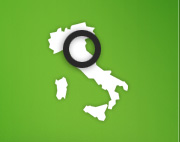History of Rimini
From metropolis of fine arts to Teutonic grill
Rimini saw its ups and downs. Established as a junction between Po Valley and the Adriatic Sea, the city was integral part of the Roman Empire and would only gained communal independence later on. Under the reign of the Malatesta family Rimini became one of Italy’s cultural centres before transforming into a popular holiday resort – initially for German tourists, currently for Russian and domestic tourists.
Important Adriatic harbour Rimini
Rimini was founded by the Romans in 268 BC and was given the name Arminium based on the ancient name of the Marecchia River. As a geographically favourably situated junction between Po Valley and the Adriatic Sea, the 220 BC constructed Via Flaminia ended here with Via Emilia leading to Piacenza beginning in Arminium. The Roman colony made Municipium – a Italian country town of sorts with full civil liberties – saw its first heyday in Late Antiquity owing to its strategically favourable connection to the west coast of the Roman Empire and its role as one of the most important Adriatic harbours of the Roman fleet aside Portus Classis near Ravenna.
New perspective for Rimini in the Middle Ages and Early Modern History
It took long before Rimini could passably recover from the commotion of the Migration period. It didn’t gain communal independence until the 12th century. The rise of the Malatesta from Verucchio began approximately at the same time. They were originally enrolled as Condottieri, i.e. mercenary leaders, at the Italian city state from the Late Middle Ages onwards, in the event of war. Instead, they already assumed power in the mid-14th century and became the masters of Rimini.
Rimini’s art world saw an unrivalled, to this day unequalled boom under the Malatesta. Sophisticated and ruthless Sigismondo Malatesta (1417-1468) led important poets and artists such as Filippo Brunelleschi, Piero della Francesca and Leon Battista Alberti to his court. He decided on, among other things, the modification of San Francesco church. The political downfall of the Malatesta eventually led to the discontinuation of the construction of the upper floor and the dome of Tempio Malatestiano in 1461. Pandolfo Malatesta, the last offspring of this dynasty, was exiled by the citizens and freed by the pope in 1528. He ultimately sold Rimini to Venice wherewith the city belonged to the Papal States until the 19th century.
Tourist hotspot and Teutonic grill Rimini
Rimini’s historically first public bathing beach was inaugurated on 30 July 1843 with the city being part of the Papal States until 1860. Railway construction and the discovery of seaside tourism were crucial for the rapid upswing to a popular holiday resort that rose like a phoenix after the severe bombings it sustained during World War II. With more and more Germans holidaying in Rimini from the 60s onwards, the city was dubbed “Teutonic grill” due to its mass tourism, before migration to Mallorca and Lloret de Mar started during the 80s. Today Rimini is popular with Russian and domestic tourists cavorting in one of the approx. 250 bagni.


Tweet